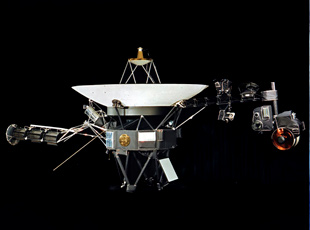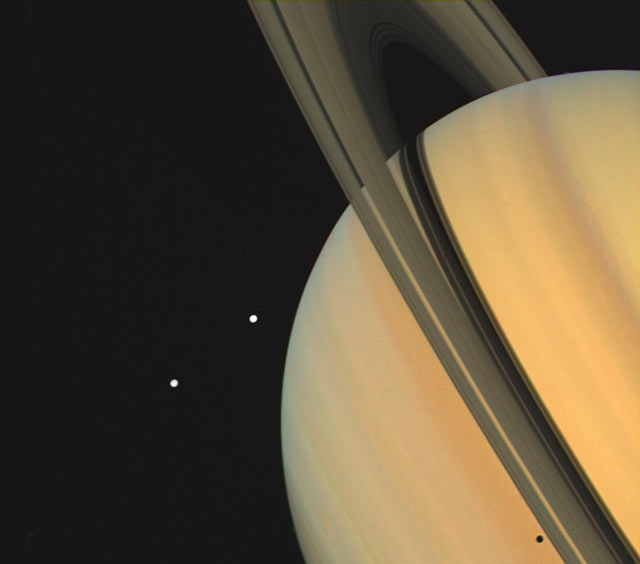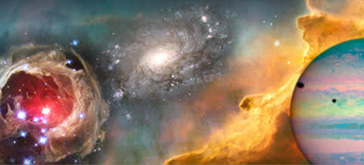ASTRONOMY AND THE PLANETARIUM
Space Exploration Experience
 Jackie spent 20 years working for NASA at the Jet Propulsion Laboratory in Pasadena, California. He started in 1977 on the Voyager Project,
two amazing space probes that explored much of the Solar System.
Voyager 1 explored the systems of Jupiter and Saturn while Voyager 2's
trajectory allowed it to vist Uranus and Neptune after flying by
Jupiter and Saturn.
Jackie spent 20 years working for NASA at the Jet Propulsion Laboratory in Pasadena, California. He started in 1977 on the Voyager Project,
two amazing space probes that explored much of the Solar System.
Voyager 1 explored the systems of Jupiter and Saturn while Voyager 2's
trajectory allowed it to vist Uranus and Neptune after flying by
Jupiter and Saturn. After Voyager 2 Saturn Encounter, Jackie began work on the Galileo Project, a Voyager-like spacecraft that was sent back to Jupiter to orbit and collect detailed data. After Galileo began its orbital
 operations,
Jackie worked on the Space Station Program, the Mars Observer
Mission, and then spent a 5 years on the Earth-orbiting satellite
mission known as the Ocean Topography Experiment (TOPEX). On TOPEX he led the Mission Planning and Sequencing Team.
operations,
Jackie worked on the Space Station Program, the Mars Observer
Mission, and then spent a 5 years on the Earth-orbiting satellite
mission known as the Ocean Topography Experiment (TOPEX). On TOPEX he led the Mission Planning and Sequencing Team.  After
TOPEX, Jackie decided that education rather than engineering was
his passion. He left JPL to focus on his doctoral program, but soon was
was invited to return as the Educational Outreach Manager for the Pluto Express PreProject, the Europa Orbiter, and Solar Probe
missions. Together they were called the Ice and Fire Preprojects.
These were the study missions that developed the plans that
later became real and resulted in the New Horizons mission to Pluto, which launced on January 19, 2006. It will flyby Pluto in January of 2015. The
Europa Orbiter and Solar Probe missions are still under development. As
Education Outreach Manager, Jackie and Richard Shope trained thousands of
educators in progressive teaching techniques.
After
TOPEX, Jackie decided that education rather than engineering was
his passion. He left JPL to focus on his doctoral program, but soon was
was invited to return as the Educational Outreach Manager for the Pluto Express PreProject, the Europa Orbiter, and Solar Probe
missions. Together they were called the Ice and Fire Preprojects.
These were the study missions that developed the plans that
later became real and resulted in the New Horizons mission to Pluto, which launced on January 19, 2006. It will flyby Pluto in January of 2015. The
Europa Orbiter and Solar Probe missions are still under development. As
Education Outreach Manager, Jackie and Richard Shope trained thousands of
educators in progressive teaching techniques.
Planetarium Experience
 Jackie's love of the planetarium began when he visited Griffith Observatory
in Los Angeles on a high school science club field trip. Years later,
while studying astronomy at the University of Southern California, he
got a part-time job as a tour guide there and he later became the tour
guide supervisor.
Jackie's love of the planetarium began when he visited Griffith Observatory
in Los Angeles on a high school science club field trip. Years later,
while studying astronomy at the University of Southern California, he
got a part-time job as a tour guide there and he later became the tour
guide supervisor. 
Jackie has found an excuse to get his classes into a planetarium whenever he can and as a result, has operated a number of different kinds of planetaria.
Beverly Hills High Planetarium
He has used the planetaria at Santa Monica College and Beverly Hills High School, both in California.
University of Washington Planetarium
In 2011, Jackie began volunteering as a planetarium lecturer for the University of Washington Department of Astronomy. They give free shows to any school group or public organization that request one. A couple times a month, Jackie gives shows to groups from age 3 on up. He considers those shows to be very important, rewarding experiences. About the planetarium experience, Dr. Jackie says,| "I consider the planetarium experience very special and vital, both to the general public and those immersed in the practice of research in the sciences. Being able to replicate the human experience of the night time sky and to use that as a backdrop to connect modern science with people and cultures throughout time is priceless. I have seen countless people of all ages leave my planetarium experiences touched for all time." |
"You are a terrific speaker and I could not have enjoyed the class more. I am
thoroughly excited about the possibilities with my new found knowledge; it
[already made] my studies so much easier last night. "

Testimonials
